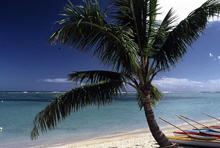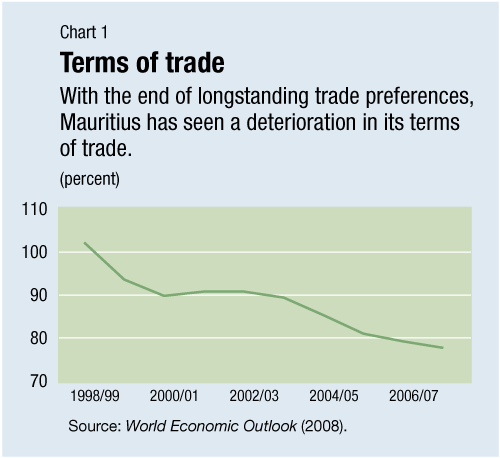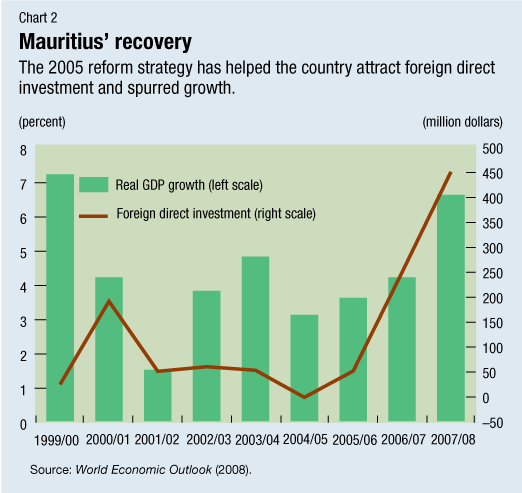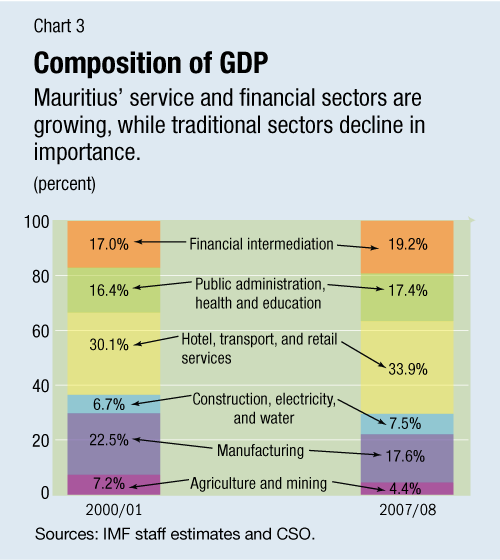
Typical street scene in Santa Ana, El Salvador. (Photo: iStock)
IMF Survey: Mauritius: Paving the Way for a Second "Growth Miracle"
July 23, 2008
- Reform strategy responding to a large terms of trade shock is bearing fruit
- Mauritius seeing strong growth in tourism, banking, and other emerging sectors
- Foreign direct investment is rising rapidly, reaching $450 million in 2007
When Mauritius gained independence 40 years ago, many observers, among them Nobel prize-winning economist James Meade, wondered how the country—a multi-ethnic society that was distant from world markets and had few natural resources, a one-crop economy (sugar), a small domestic market, and rapid population growth—could ever develop.

Mauritius' growth, projected to be above 6 percent this year, is especially strong in tourism, banking, construction, and services (photo: Newscom).
ANNUAL ECONOMIC HEALTH CHECK
Mauritius proved Meade and the others wrong during the "first growth miracle" of the mid-1970s through the mid-1990s. This miracle was founded on the traditional sugar sector, a new textile sector based in export processing zones, and an emerging tourism sector. Remarkably, the Indian Ocean island nation was able to raise per capita income from $200 at independence to $3,700 in 1997. Strong democratic institutions, which promoted social cohesion, were key to the country's success.
Trade preferences phased out
But after two decades of impressive growth, the tropical island of 1.3 million people suffered at the turn of the millennium as longstanding trade preferences began to be phased out. The end of the Multi-Fiber Agreement (MFA) for textiles in December 2004, large reductions in the European Union's sugar protocol prices (by 36 percent) announced for 2006-10, and, more recently, the sharp rise in petroleum and food prices resulted in a cumulative terms of trade shock of nearly 25 percent (see Chart 1). Economic growth declined from 5 percent in the 1990s to 3 percent in the early 2000s.

The adjustment and reform challenge
In response to this triple shock, the government launched a wide-ranging reform strategy in 2005 that is bearing fruit (see Chart 2). Trade was liberalized, some price controls were lifted, business regulations were simplified, a far-reaching tax reform and a fiscal consolidation strategy were initiated, and monetary policy was strengthened.
In response, growth has recovered and foreign direct investment is flowing into the country at unprecedented rates. Growth, projected to be above 6 percent this year and next, is broad based but especially strong in tourism, banking, construction, and services.

As part of the strategy, the authorities introduced reforms to encourage business development and employment growth. The Board of Investment, a specialized agency, took charge of promoting foreign investment and reducing registration and licensing requirements. Their efforts bore fruit—the World Bank's Doing Business 2008 lists Mauritius as the best place to do business in sub-Saharan Africa.
The reforms have also focused on fiscal consolidation, which helps preserve domestic and external stability by reducing public debt levels and the external current account deficit. Fiscal consolidation is needed to bring public sector debt down from a high of 81 percent of GDP in 2002/03 and to counter the strong aggregate demand from the large foreign investment inflows. The authorities have made good progress in reducing the fiscal deficit since 2005/06, building on the positive revenue impact of the tax reform. This reform, which featured a flat 15 percent personal and corporate income tax, was designed to make the system more progressive, expand the base, and facilitate administration. A new public debt law and finance audit act are aimed to support public debt reduction to around 50 percent of GDP in the medium term.
Another key element of the reform strategy is strengthening monetary policy. The central bank is working to bolster its analytical framework through a better understanding of the monetary transmission mechanism and to strengthen its governance structure and communications. However, large capital inflows pose challenges for monetary policy, as a desired monetary tightening to counter capital-induced demand pressures may actually attract more inflows. The authorities established the Monetary Policy Committee in 2007, an important step toward increased transparency and effectiveness. Two new semiannual reports on inflation and financial stability will be published beginning in mid-2008.
Traditional sectors adjust
The structure of Mauritius' economy is changing rapidly (see Chart 3), and the sugar and textile industries have had to adapt to new realities. The sugar industry, a pillar of development since colonial times, is consolidating and restructuring. The area planted is being reduced, with land converted to tourism and other agricultural uses.
Producers are also expanding into related activities, such as power generation from sugar cane residue (bagasse) and ethanol production, and are moving up the supply chain into refined sugar. The development of "flexi-factories" able to switch production between sugar and ethanol will make the sector more adaptable and responsive to developments in international markets.
The textile sector has, after years of restructuring and decline, begun to grow again in 2007/08. With the dismantling of the MFA, many producers closed or moved abroad. Of the firms that remained, largely locally owned, some have prospered through a vertical integration strategy refocusing on higher quality products. Such a strategy allows Mauritian companies to respond quickly to style and market changes. This, together with higher quality focus, has enabled Mauritian companies to differentiate themselves from low-cost producers in China.

Emerging sectors
Mauritius has seen very rapid growth in its offshore financial sector. The sector's growth is founded on Global Business License firms—entities registered in Mauritius that funnel investments into their targeted country, primarily India. Given Mauritius' low tax rates (and no capital gains tax), this system has effectively allowed low-tax or tax-free investment channels to India and elsewhere.
A high-end real estate development initiative—the Integrated Resort Schemes (IRS)—tied to the tourism sector, is developing rapidly, drawing in large amounts of foreign direct investment. Foreigners buying into an IRS are eligible for domestic residency. This leverages the new tax regime and existing tourism infrastructure. Mauritius has also sought to position itself as a platform for investment from China and India to east Africa. Large investments from China, which is using Mauritius as one of the five strategic countries in Africa, are planned.
The challenge of managing success
Recovering growth and rising foreign investment inflows have lifted the economy and reduced unemployment. However, the economy is facing rising labor, infrastructure, and other bottlenecks. The authorities are also facing strong headwinds from international commodity prices, and inflation, although declining, remains high. The key macroeconomic challenges are to reduce the fiscal deficit to counter demand pressures, strengthen monetary policy, and pursue structural reform to spur economic efficiency. Growth is expected to remain strong over the medium term, supported by rising investment inflows.
Mauritius will need to broaden the structural reforms to spur economic efficiency and create fiscal space for much-needed spending on public infrastructure and education. Building on recent successes, second-round reforms on the expenditure side of the budget aimed at targeting social spending are needed. Such targeting will also introduce a helpful countercyclical component to fiscal policy, as social payments will tend to decline in periods of prosperity. A disengagement and disinvestment strategy for parastatals would be helpful to reduce quasi-fiscal spending and raise efficiency.
Labor market reforms are also needed. Some have already been initiated, but the authorities could take further steps to upgrade the skills of the workforce and increase labor market flexibility.
A second growth miracle?
Mauritius is in the process of reducing its fiscal deficit and public debt and addressing its structural weaknesses to secure a second growth miracle. There is encouraging evidence that the important reforms introduced since 2005 are bearing fruit. Looking ahead, the challenge for the authorities will be to sustain noninflationary growth. The authorities' ambition is to see Mauritius transition to a regional banking and services hub. For this goal to be realized, the bold reform process started in 2005 will need to be pursued and deepened, with special attention to managing demand pressures and removing the constraints to higher growth.
Comments on this article should be sent to imfsurvey@imf.org







